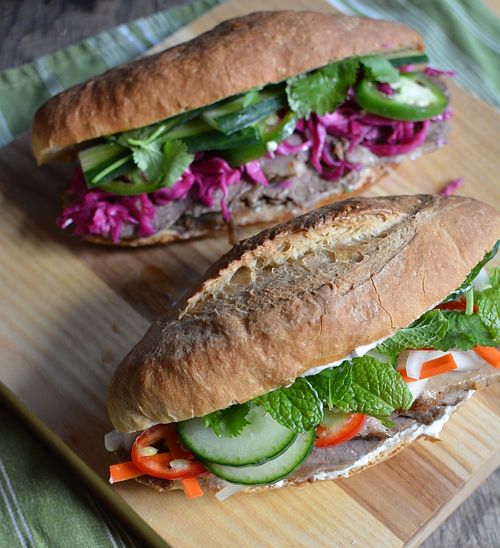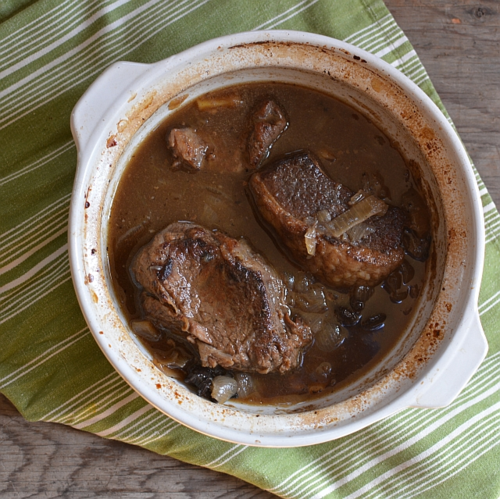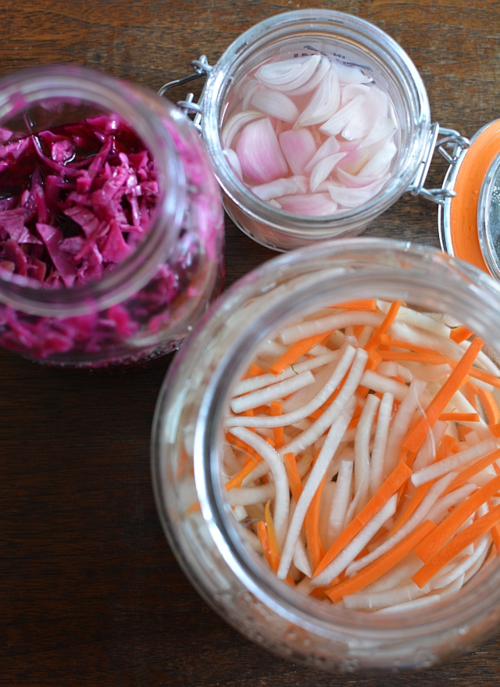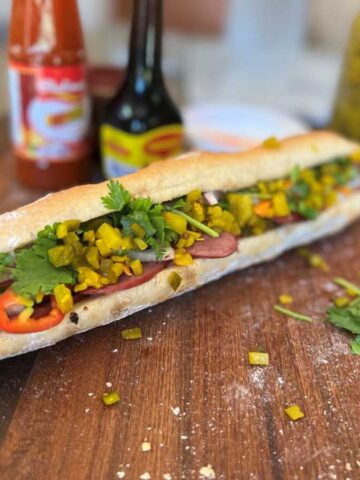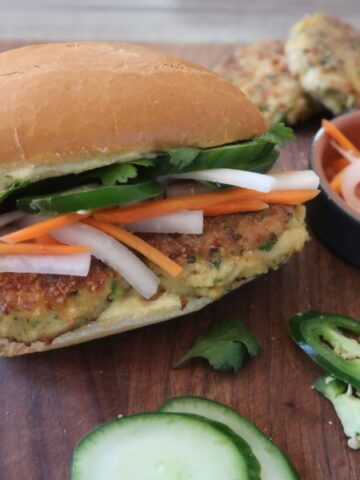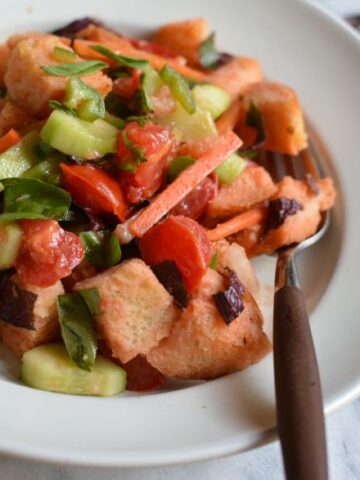A while back, someone on Twitter alerted me to a pho banh mi at Andrew Le's The Pig and The Lady in Honolulu. It was suppose to be divine, the person said. I wasn’t about to hop on a plane to Hawaii, but when I was in Los Angeles this summer, I tried the pho banh mi at Chloe Tran’s East Burough in Culver City. She served it with a side of pho broth to offer a Viet twist on an American classic. Chloe told me that the genesis of her creation was simply “Why not?” and it worked!
When I ate it, I found myself not dipping the sandwich in the broth because for me, banh mi is not wet. Plus sipping on her lovely broth made for a terrific soup and sandwich combination.
Chloe got me thinking about how to combine two iconic Viet dishes into one. At first, I tried just using leftover cooked beef and broth from a batch of pho. The beef wasn’t tender enough for sandwiches. It was okay but not right. The lazy approach didn't work.
Then I took a page from my favorite beef dip sandwich – that which is made at Philippe the Original in Los Angeles. I’d eaten at the old timey restaurant many times over the years. I’d watched the ladies place just a moderate amount of thinly sliced, moist meat onto the soft rolls. I’d even made my own at home based upon what I observed at the Los Angeles restaurant and recipes from James Beard's classic American cookbook.
Given my past observations and experimentation, I made a pot roast of sorts but cut the beef into big chunks. The result was tasty. My husband said the meat made a good beef sandwich with pho flavors. We tried it with three pickles I had in the house -- daikon and carrot pickle, citrusy red cabbage pickle and pickled shallot (Banh Mi Handbook, pages 33, 34, and 36); I tucked the shallot in with the other two pickles for a little oniony bite. The slaw-like quality of the red cabbage paired nicely with the beef.
I think the bean sprout pickle (dua gia) recipe in Into the Vietnamese Kitchen (page 193) would be good too. I would not put just raw, plain bean sprout into the sandwich as its flavor alone doesn’t say enough.
Herb-wise, I love cilantro and mint with pho so that’s what I favored accenting my pho banh mi. If you enjoy Thai basil, go for it! Both regular mayo and Sriracha aioli tasted good with the beef. I used different colored chiles depending on the pickle because I wanted color contrasts in the sandwich. Banh mi should look and taste like a party.
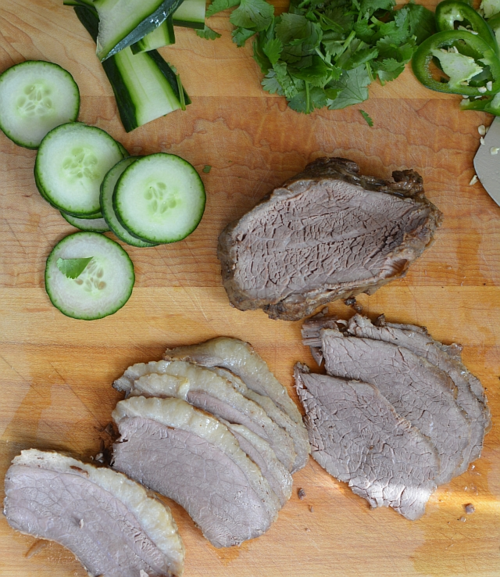
Try this out and let me know your thoughts. It kept well in my fridge for days, and is great for entertaining. {Hint}
Thanks Andrew and Chloe for the banh mi inspiration.
Recipe
Beef Pho Banh Mi
Yield: Enough for 6 sandwiches
Ingredients
- 1 small (6 oz / 180 g) yellow onion
- 1 ½-inch (3.75 cm) fat knob ginger
- 2 pounds (900 g) beef brisket, boneless chuck or cross-rib roast
- Salt and pepper
- Brown sugar
- Canola oil
- 2 star anise (16 robust points)
- 3 cloves
- A 3-inch piece of cassia bark or cinnamon stick
- 2 tablespoons fish sauce
Instructions
- Char the onion and ginger as you would do to make pho. Use an open flame on a gas stove or grill or broil super close to the heat element. Rotate the aromatics often and use the exhaust, if applicable. This takes about 10 minutes total. Cool, then peel and rinse well. Cut the onion into thick slices. Halve and smash the ginger. Set aside. (See the pho recipe for guidance.)
- Meanwhile, cut the beef into 3 pieces of roughly equal size. Season well with salt, pepper and brown sugar. Set aside.
- Position a rack in the middle of the oven and preheat to a moderately-low temperature (300 to 325 F / 150 to 160C). Select a medium oven-proof pot (e.g., a claypot, donabe or ceramic coated cast iron) to cook the beef; the meat should fit comfortably in it with a knuckle’s worth of clearance all around.
- Use a dry medium skillet or shallow pan to toast the star anise, cloves, and cassia over medium heat until fragrant. Set aside. Add a splash of oil to the skillet, raise the heat to high, then brown the beef on all sides. Transfer the beef to the pot. Deglaze the skillet with 1 ⅓ cups (330 ml) of water, scraping up bits clinging to the walls. Off heat, add the fish sauce and ¼ teaspoon salt. Taste and it should be pleasant but a touch light (you’ll cook it down later). Tweak flavors, if needed, then pour into the pot.
- Most of the beef should covered in liquid. Strew the onion, ginger, and spices all around the beef. Cover, then slide into the oven to bake for 2 hours. Turn the beef midway. Uncover and bake for another about 1 more hour. The beef should feel firm-tender when done. Cool, uncovered. (At this point, you can refrigerate the pot up to 5 days.)
- Remove the beef, then skim as much fat as you’d like. Use a slotted spoon to remove the solids from the cooking liquid. Taste and then imagine the flavor concentrating to an intense beefy-pho flavor. To achieve that, bring the cooking liquid to a boil and let it boil away to roughly ⅓ to ½ of its volume after cooking. Taste to verify the flavor. Add fish sauce or salt, if needed for a strong flavor. Keep warm.
- To use for banh mi: Thinly slice the beef across the grain. Replace the beef in the warm cooking liquid to soak up flavors, then layer it into your sandwich. Try using the cooking liquid instead of Maggi to flavor the bread after you lay down the mayo. Any of the pickles work. Mint with or without cilantro help the pho flavors pop.
Related posts and sites:
- Banh mi bread buying tips
- Thanksgiving Leftovers Banh Mi Tips
- Pork and Eggs Simmered in Coconut Juice (a pot roast that you can put in banh mi)
- Lemongrass Pork Sausage Banh Mi Recipe
- East Borough (Culver City)
- The Pig and The Lady (Honolulu)













